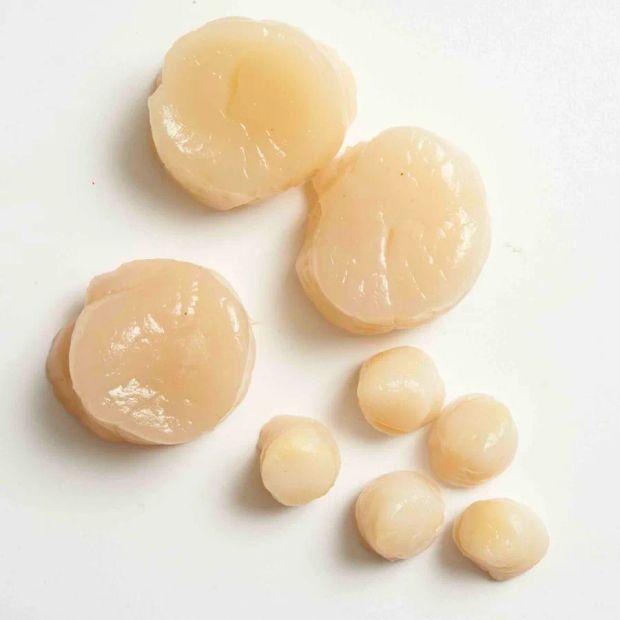Bay Scallops vs Sea Scallops: Understanding the Key Differences

Scallops can elevate a simple pasta dish to a gourmet experience. But a visit to your local fishmonger reveals that there’s more than one type of scallop to choose from.
Scallops come in several varieties, including bay and sea scallops. Here, you'll discover the differences between them and get expert tips on selecting the right scallops for your recipe.
What Exactly Are Scallops?
You may know them as delicate, tender morsels from your favorite seafood spot, but scallops are actually bivalve mollusks with two hinged shells. The edible part is the abductor muscle, which opens and closes the shell.
Bay Scallops vs. Sea Scallops: A Quick Comparison
Scallops generally fall into two categories: bay and sea scallops. You’re probably most familiar with sea scallops, as they are the largest and most commonly served type, often found in restaurants.
Sea scallops are harvested year-round from depths of up to 200 meters in cold ocean waters. Typically, they range from 1 ½ to 2 inches in diameter, with a pound containing about 20 to 30 scallops. While slightly chewier than the tender bay scallops, they still require only a brief cooking time. Check out our guide on how to cook scallops for more details.
Bay scallops, in contrast, are found in the shallow, chilly waters of East Coast estuaries and bays. Smaller than sea scallops, they measure about ½ inch across and typically weigh between 50 to 100 per pound. Their smaller size gives them a sweeter flavor and a more delicate texture, and they're usually more affordable than the larger sea scallops.
Other Varieties of Scallops
Calico Scallops
Often mistaken for bay scallops, calico scallops are harvested from the warm waters along the Atlantic and Gulf Coasts, stretching from Florida to Central and South America.
Smaller than bay scallops, with 100 to 200 calico scallops making up a pound, they stand out due to their striking red and pink patchwork patterns on the shell. Calico scallops are the most affordable variety.
Patagonian Scallops
I recently picked up frozen Greenwise Patagonian Scallops from Publix, opting for them over the pricier sea scallops. These small, sweet, and tender scallops are similar to bay scallops, and I used them in Chef John's Bay Scallop Chowder recipe as a perfect substitute.
After a bit of research, I discovered that these scallops come from the frigid Antarctic waters just off Argentina’s coast. Quite an interesting fact!
Shopping for Scallops
There’s more to know when it comes to selecting scallops. While picking the right type is important, you’ll also need to decide between fresh or frozen, and wet- or dry-packed. Let’s break it down.
Fresh vs. Frozen Scallops
Should you buy fresh scallops from the fishmonger or opt for frozen ones? Surprisingly, frozen scallops are often the freshest choice. Unless you live near the coast, your ‘fresh’ seafood was probably frozen at sea and thawed for sale. Frozen scallops have been preserved at their peak freshness, making them the better option for those without access to local, fresh seafood.
Wet-Packed vs. Dry-Packed Scallops
Whenever possible, choose dry-packed scallops, and here’s why: Wet-packed scallops are soaked in a phosphate solution to whiten them and make them absorb more water, which extends their shelf life. But what you’re really paying for is water, which will evaporate during cooking, causing your scallops to shrink to a fraction of their original size.
This soaking process can also result in tougher, less flavorful scallops. For better quality and value, always opt for scallops labeled ‘dry-packed’ or ‘chemical-free’ for a superior product.
Diver and Dayboat Scallops
Don’t be confused by the terms ‘diver’ or ‘dayboat’—they refer to how the scallops were harvested. Diver scallops are hand-harvested by divers. This method is considered more sustainable because it’s selective and causes less harm to the ocean floor, but it comes at a higher price.
Dayboat scallops come from a unique harvesting method. These scallops are caught on boats that return within 24 hours, ensuring that the scallops are sold fresh and at their peak. Like diver scallops, dayboat scallops are among the priciest on the market.
Most commercially available scallops, however, are harvested through trawling, a method where the ocean floor is scraped for scallops that are then immediately frozen to maintain their freshness.
Evaluation :
5/5



